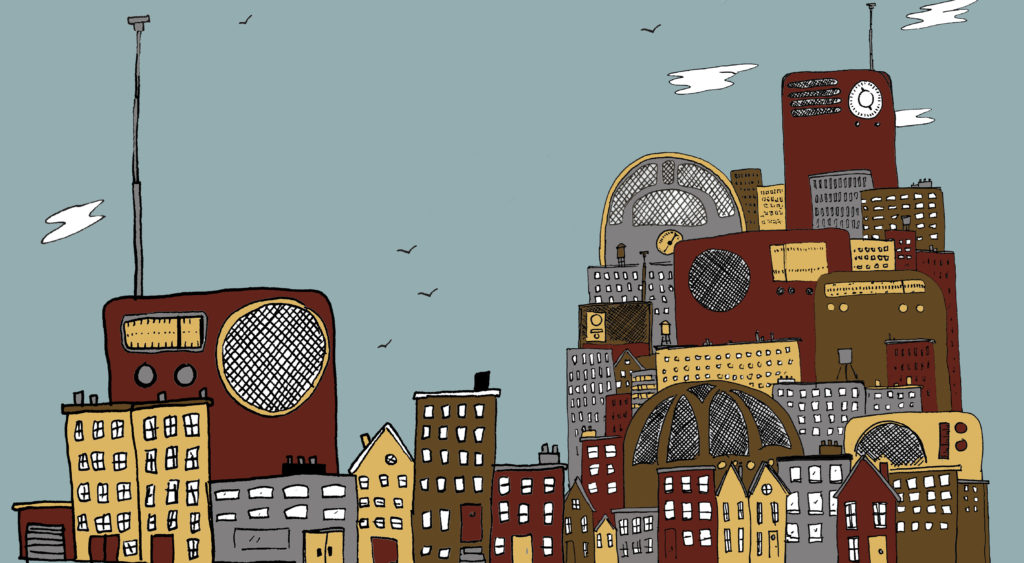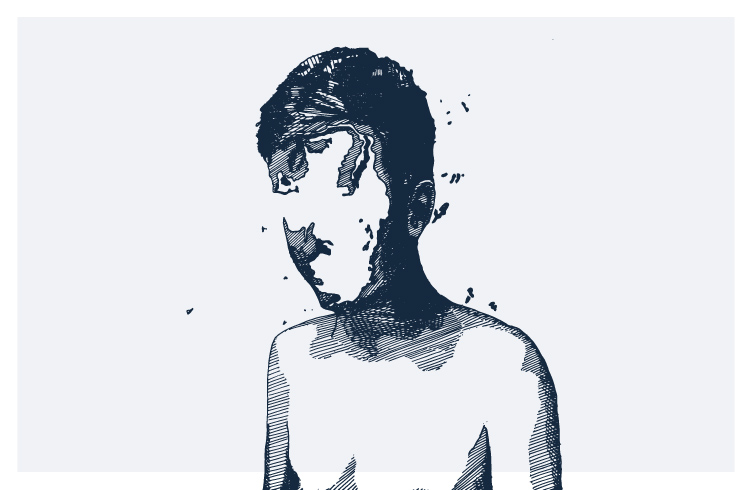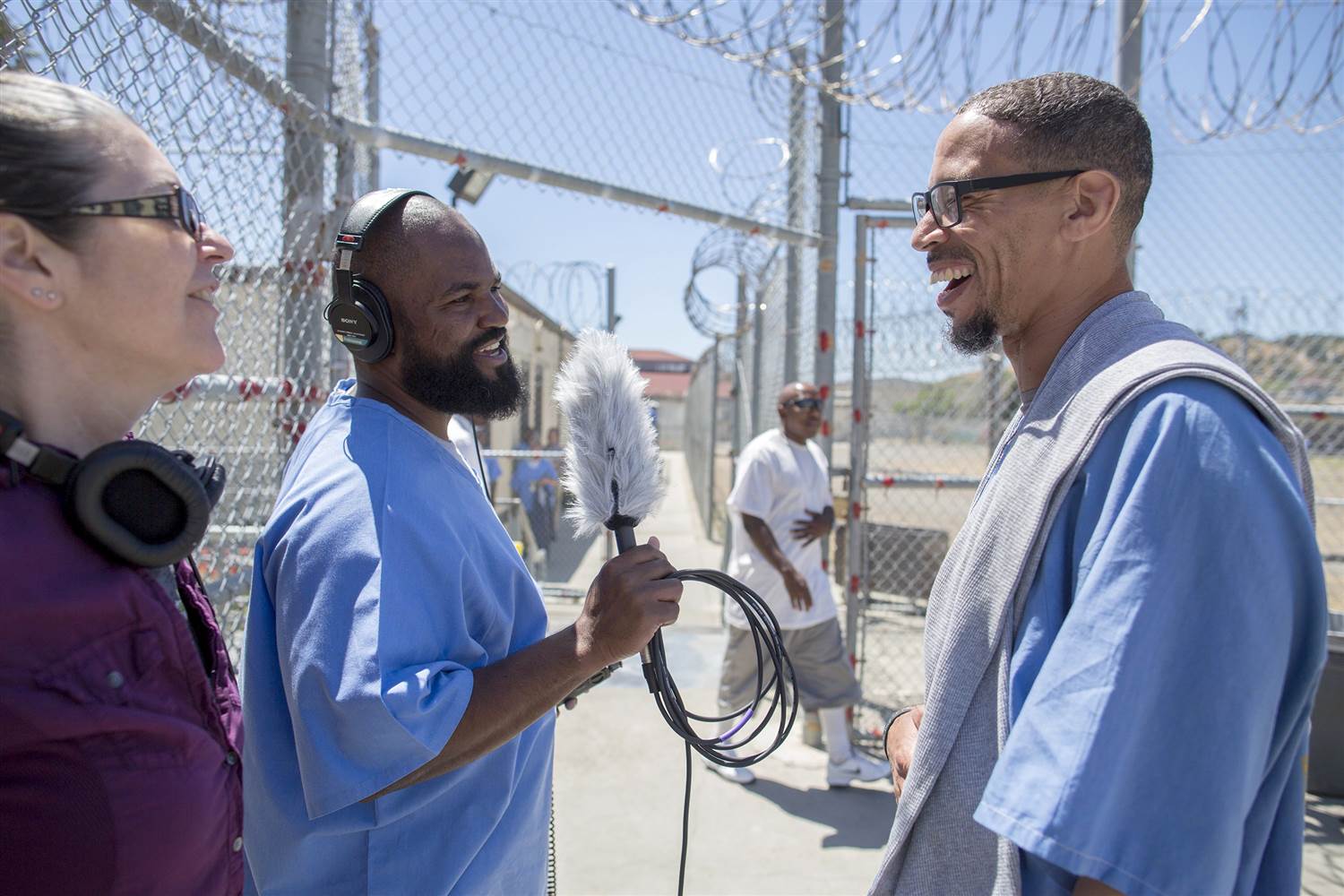Voices from Below: Storytelling Podcasts and the Politics of Everyday Life
Andrew J. Bottomley / SUNY Oneonta

The goal of storytelling is to make the audience live the storyteller’s experience. “The storyteller takes what he tells from experience – his own or that reported by others,” writes Walter Benjamin, “And he in turn makes it the experience of those who are listening to his tale.” [1] As an oral tradition, the act of storytelling situates the narrator in a relationship with a larger audience. Storytelling is a form of giving. Certainly, you can teach with a story or persuade with a story, but true storytelling should not make any demands of the audience other than simply to listen. The aim is to invite listeners to interact with the story and interpret it’s meaning individually.
Over the past decade, a growing number of introspective first-person podcast series have focused on affect and lived experience, exploring the lives of ordinary people in emotional depth and detail. The term “audio storytelling” has sprung up to describe these narrative- and character-driven podcasts. [2] The audio storytelling category is broad and rather ambiguous, encompassing live storytelling podcasts (think: The Moth, Mortified), memoir-style personal documentaries (think: Millennial, How to be a Girl), essay-like historical narratives (think: The Memory Palace, You Must Remember This), and non-narrated stories (think: Everything is Stories, This is Actually Happening). Whatever the format, the essence of audio storytelling is based around the voices of ordinary people and their personal experiences, memories, and commentaries.

I am focusing here on the non-narrated mode, and specifically on the podcast Love + Radio. In contemporary podcast production, the term “non-narrated” refers specifically to a documentary audio piece where there is no narration from a host or reporter. The piece consists entirely of an interview with someone – and typically that someone is an “ordinary person,” meaning anyone who is not a celebrity, politician, media professional, social elite, or newsworthy figure. Usually they are recorded in the field, not in a studio. The interviewer is sometimes heard in the piece, though her interjections are kept to a minimum. In many cases, the piece is edited so the interviewer is excised entirely, resulting in the “story” being presented as a monologue where the subject’s voice is the only one heard. [3] To quote Radio Diaries producer Joe Richman, the objective of these non-narrated programs is to tell “the extraordinary stories of ordinary life.” [4]
Love + Radio was one of the first podcast-only series to adopt the non-narrated approach, beginning back in 2005. Spearheaded by Nick van der Kolk, the Radiotopia distributed podcast features stories contributed by a rotating team of producers and freelancers. Even though they occasionally deviate from the non-narrated mode with straight one-to-one interviews, its subjects are always ordinary people. And these subjects are given a platform to speak mostly uninterrupted for lengthy periods of time: episodes run anywhere from 20-minutes up to an hour. The affordances of podcasting – unrestricted length, low production and distribution costs, absence of FCC regulation – allow producers to tell long, often intricate stories that range from the mundane to the sensational, placing special emphasis on individual experience and affect. Love + Radio, in particular, tends to feature subcultural or marginalized subjects who are either entirely overlooked by most popular media or, if they are represented, who are framed as deviants, social pariahs, or one-dimensional stereotypes: sex workers, pimps, cult members, con artists, drifters, prisoners, pedophiles, stroke survivors, drug dealers and drug addicts. These are highly sensitive and controversial issues that, no matter how delicately they might be discussed on broadcast radio, would have a hard time getting past station program directors or FCC regulations.
Podcasts like Love + Radio give these individuals a platform on which to voice perspectives that are transgressive and frequently challenge the ideological status quo. The long running time and lack of host narration in a non-narrated podcast immerses listeners in the subject’s personal narrative, inviting the audience to focus on the motivations behind people’s actions. These questions of why are typically left out of standard journalistic reports, which mainly focus on the what, the consequences. In the least, audiences are encouraged to reflect on the narrator’s story and draw their own conclusions.

An example. The 2013 episode “Jack and Ellen” is the story of a young woman, Ellen, who escapes her dead-end job as a Subway “sandwich artist” to become what she calls “a professional blackmailer.” Specifically, she pretends to be a 15-year-old boy on Craigslist in order to lure in pedophiles and blackmail them – a practice known as pedobaiting. Through her alter ego “Jack,” she estimates she has extorted 100 people for a total of $30,000-$40,000. To begin, the subject matter of the episode is sexual solicitation and pedophilia: topics that are certainly covered in the traditional news media, albeit typically in a narrowly defined and conservative manner. In contrast, Love + Radio spends a full 31-minutes on Ellen’s story, discussing the topics with much more candor than broadcast journalism ever could, leaving the more explicit and unsavory details intact rather than tiptoeing around them. Indeed, while pedophilia is nearly universally abhorred, Ellen’s catfishing and blackmail are also morally objectionable (and illegal) activities. Her story, therefore, is full of moral ambiguity: the actions of the pedophiles are detestable and criminal, yet Ellen’s exploitation of them is too. Since the Love + Radio producers refrain from narrating Ellen’s story or attaching a fixed moral lesson to it, listeners are openly invited to draw their own conclusions about the ethical dilemmas presented in the story.
The longform structure of a podcast like this reveals emotional textures and intricacies that a short 4-minute story on, say, All Things Considered simply cannot capture. Over the course of the podcast, Ellen develops from a rather one-dimensional, unmerciful character into a dynamic young woman who is conflicted by being a blackmailer but manages to find ways to rationalize her actions anyway. Among other things, we eventually learn that Ellen is a lesbian, which she admits puts her in a morally complicated position. Listen to this clip, in which Ellen justifies her blackmail.
One area where audio storytelling has a significant advantage over other forms of digital storytelling is through aurality: sound gives us access to what was said as well as how it was said. Audio captures communicative aspects of the speaker’s voice such as tone, stress, volume, speed, pitch, accent, dialect, and other subtle speech dynamics and rhythms, which carry a whole subtext of meaning. Indeed, in the beginning of her story, Ellen is very matter-of-fact about her catfishing and, hearing her voice, she sounds unfeeling and remorseless – which initially makes her difficult to empathize with, even if the pedophiles she’s blackmailing are also disdainful characters. As the conversation progresses, however, Ellen’s tone becomes lighter and her pace gets less terse, which makes her sound more open and expressive – if not likable, she at least becomes a more rounded figure. She’s still a criminal, but we begin to understand how she came to be where she is – and that complexity is communicated as much through the sound of her voice as it is through the content of her words.
A similar example of the power of sound in non-narrated audio storytelling comes from the episode “Eternity Through Skirts and Waistcoats,” which features another gay woman, Norah Vincent, who disguised herself as a man – this time as what she calls “an immersive journalist” reporting on gender relations. In this clip from the episode, we hear her audibly transition into her male alter ego, Ned, which has a very different impact when heard rather than read on a transcript.
A few takeaways. To start, radio and podcasting are particularly well suited to the everyday, experiential type of personal narratives that I quoted Walter Benjamin describing in my introduction. “The everyday” is a foundational concept in media and cultural studies, of course, and the basis for the field’s investigations into popular culture and lived experiences, especially the experiences of disenfranchised or marginalized social groups. Raymond Williams’ idea of “structure of feeling” is appropriate here: it describes the shared values of a particular group or society in a specific historical moment, defined through the actual affective social character of a period. [5] The long duration of storytelling podcasts and their commitment to people’s individual experiences and emotions, rather than traditional politics or “hard news” topics, captures this felt social character of a period. Moreover, podcasts like Love + Radio are highlighting points of view that are too often unheard or under-recognized in other mass media. This attention to the lived experiences of people outside the cultural mainstream helps expand the range of discourse circulating in the mediated public sphere.
Now, a lot of audio stories – particularly public media programs like This American Life and its many clones – claim to cover “everyday lives.” Jason Loviglio has rightly critiqued This American Life for in actuality representing a rather narrow range of people and perspectives that resemble the demographics and tastes of the show’s predominantly white, upper-middle-class, educated audience. What’s more, the emphasis on individual experiences favors “slice-of-life” vignettes that privilege personal struggles over societal problems. These character-driven stories, says Loviglio, obscure the larger issues of politics, policy, and other deeply-rooted institutional and historical factors, promoting the neoliberal moral that “the impetus for social change resides in the character of specific people, not in the intolerable social conditions that many people confront.” [6]
This line of critique could certainly be applied to Love + Radio. The episode “The Silver Dollar,” for instance, features an African-American musician, Daryl Davis, whose approach to overcoming white racism is to personally befriend Ku Klux Klan members. In this clip, Davis claims former KKK Imperial Wizards and Grand Dragons amongst his close personal friends.
In fact, the episode ends right there. Since there is no host narration providing a critique, listeners could be forgiven for interpreting the lesson of Davis’ life story as being that racism is an individual rather than a systemic problem, and that the best way to effect positive social change is through personal action rather than any political initiative or collaborative effort. This is a decidedly neoliberal message.
It is conventional for modern audio storytelling to offer some sort of narrative “surprise” or “twist” – the result being to highlight stories that are more extraordinary than ordinary. [7] As much as I admire the program, too often the voices in Love + Radio end up resembling a rogues’ gallery of misfits and eccentrics: pimps, sex workers, mafioso, bank robbers, pedophiles, crime scene cleanup specialists, surrealist artists. Plenty of Love + Radio episodes focus on less ostentatious subjects; nevertheless, the series (and numerous other podcast series like it) has a kitschy fascination with the weird, the outlandish, and the sensational that pulls attention away from the truly ordinary or everyday.

The industry lore that a “good story” needs narrative surprise leads many podcast producers to seek out a too-narrow group of subjects and narratives. As a result, the promise of audio storytelling to capture the full range of everyday life across all classes and cultures is going at least partly unfulfilled. As opposed to the more common This American Life-esque anthology approach of switching themes and subjects from episode-to-episode, I personally would like to see more topically focused podcasts that examine an issue or social group consistently across a series – such as a series gathering the lived experiences and disenfranchised voices of DACA immigrants, or migrants workers, or the inner-city poor. Such series could better explore the systemic nature of racism and other social problems, highlighting commonalities rather than isolated or exceptional cases. Ear Hustle is one such podcast, a new series which centers on the first-person accounts of prison life, as told entirely by inmates within a single institution, California’s San Quentin State Prison. It will hopefully become a model for others.
The inwardness of neoliberal subjectivity is a legitimate risk of first-person audio storytelling, due to its stress on individual experience over socio-historical context or critical-cultural analysis. Nick Couldry argues, however, that voice is actually the best way to challenge neoliberal political power. For Couldry, this ability to subjectively give an account of oneself and one’s experiences in the world is a basic feature of human life. It is, in fact, the one power that even the most marginalized and oppressed populations still possess. [8] The issue is not simply having “more voices” in public, but also valuing those voices: that someone’s life can become a story – a narrative that is heard by others and, in the process, is recognized as having value – is one crucial way of showing them that their experiences, and thereby their life, count. This is what audio storytelling is doing, especially non-narrated stories that make individual personal narratives the focal point. Podcasts like Love + Radio are creating spaces for marginalized (or at least stigmatized) people to speak on their own terms and tell us about themselves, and for us to listen to those self-narratives and give them meaning and purpose.
Audio storytelling is observing culture “from the bottom up,” generating the evidence of ordinary people “on the ground” that can be used to support a more expansive and fully open politics that can challenge neoliberalism. Storytelling podcasts like Love + Radio are helping a more diverse range of people to be made audible, recognizing and raising their voices. That doesn’t mean these shows aren’t without their weaknesses. There tends to be an over-emphasis on sentimental and sensational narratives. The anthology format means that individual stories wind up isolated and alone, disconnected from a larger political message or movement. Nonetheless, podcasting has revitalized and strengthened radio storytelling as a tool for participatory democracy. And, in listening to the complexities of other people’s life stories, we may learn something about the complexities of society and of our own lives, too.
Image Credits:
1. An illustration by Issac Kestenbaum for the book cover to Radio Diaries: DIY Radio Handbook
2. Logo for the podcast Love + Radio
3. Artwork for Love + Radio “Jack and Ellen” episode. Illustration by Cal Tabuena-Frolli.
4. Co-hosts Nigel Poor (left) and Earlonne Woods (center) interview inmate Rahsaan Thomas at San Quentin State Prison for the podcast Ear Hustle. Photo by Jim Seida, NBC News.
Please feel free to comment.
- Walter Benjamin, “The Storyteller: Reflections on the Works of Nikolai Leskov,” in Illuminations: Essays and Reflections, ed. Hannah Arendt, trans. Harry Zohn (New York: Schocken Books, 1969), 84. [↩]
- The industry, popular press, and fans call these programs a variety of names, including also “storytelling podcasts” and “narrative nonfiction podcasts.” I personally prefer to refer to them as radio feature-documentaries. However, I have settled on the “audio storytelling” name for this article, as it is currently the most widely recognized term. [↩]
- I am using the term “non-narrated” because it is widely used in radio/podcast production circles. However, I must point out that “non-narrated” is actually a misnomer, since the interviewee is both the subject of the discourse and the speaking subject – that is, the interviewee is the narrator. [↩]
- Joe Richman, “Manifesto,” Transom.org (2014, April 15), http://transom.org/2014/joe-richman/. Notably, too, Richman is a veteran public radio producer, and thus it must be acknowledged that this non-narrated mode of audio storytelling is hardly new to podcasting. It has a history that dates back to the 1940s and some of the earliest radio documentaries made in the U.S. The non-narrated mode has also lived a long life on NPR since the 1970s, even if it is mostly confined to short radio pieces inserted into news magazine like All Things Considered and Morning Edition. If you’re a regular public radio listener, you might be familiar with the non-narrated mode via the work of Dave Isay and StoryCorps, The Kitchen Sisters (Davia Nelson and Nikki Silva) and Lost & Found Sound or Fugitive Waves, and Richman and his Teenage Diaries and Radio Diaries series. [↩]
- Raymond Williams, Marxism and Literature (New York: Oxford University, 1977), 132. [↩]
- Jason Loviglio, “Public Radio, This American Life, and the Neoliberal Turn,” in A Moment of Danger: Critical Studies in the History of U.S. Communication Since World War II, eds. Janice Peck and Inger L. Stole (Milwaukee: Marquette University, 2011), 294. [↩]
- This storytelling strategy of using “surprise” to create narrative pleasure is widely circulated in speeches and essays from popular radio/podcast personalities, most notably Ira Glass and his fellow producers at the hugely popular This American Life. See, for instance, This American Life’s description of “it has to be surprising” on its “About Us” webpage. [↩]
- Nick Couldry, Why Voice Matters: Culture and Politics After Neoliberalism (Thousand Oaks, CA: Sage, 2010), 1-13. [↩]
Thank you for this insightful article, Andrew. I recently covered similar terrain for a commissioned article, “Truth to power: how podcasts are getting political”, for The Conversation (an outlet where academics write in plain English about their research). It delves into Australian and UK podcasts where minority voices such as refugees and LGBQTI people expressly feature – see:
https://theconversation.com/truth-to-power-how-podcasts-are-getting-political-81185
I also came across a well made podcast focused on stories of Latinos in US facing deportation: https://soundcloud.com/indefensible/sets/indefensible-podcast
One area where I might somewhat disagree with you is your assertion that these podcasts “are creating spaces for marginalized (or at least stigmatized) people to speak on their own terms (my emphasis) and tell us about themselves”. That ignores the crucial role of the producer in shaping how the interviewee is presented: through editing and mixing – what’s in/out, in what sequence, with what additional inflection through use of music, ambient sound, pacing etc. Brendan Baker, until recently a co-producer of Love +Radio, has reflected on these nuances in a critique of that podcast by Canadian producer Michelle Macklem, published in the journal of audio storytelling criticism, RadioDoc Review (disclosure: I edit this journal):
“As an editor of documentary art, I always want to represent my best understanding of truth, knowing that I’m always working with subjective perspectives. So I want to edit the piece in a way that feels intellectually and emotionally honest, and fair to my subject. I want the subject to listen to the final piece and say, “you really captured me”. And I care about the audience trusting me to portray my best understanding of the truth. That said, I also want to give the audience credit for being sophisticated enough to draw their own conclusions and react to the piece in a variety of ways. The necessary tension of portraying “truth” in a way that is open-ended enough for people to have their own emotional and intellectual reaction is the great tension of documentary art.”
Macklem compares themes such as empathy, ethics and use of sound design in two Love +Radio episodes, Jack and Ellen and The Living Room. http://ro.uow.edu.au/rdr/vol3/iss1/4/
But if we want really transparent portrayals of our interview subjects, then maybe we should do as oral historians do, and preserve the ‘raw’ interview as a separate artefact? That way if someone was misrepresented through editing to make them more attractive or less appealing, an agenda would be evident. I’ve done that with some of my radio documentaries – e.g one on religious bigotry in Australia. The indexed collection of 37 unexpurgated interviews is browseable online at the National Library of Australia (with access conditions set by interviewees), but I distilled the interviews into a 2 x 50mins crafted audio feature series, to make an engaging narrative format. It’s called Marrying Out, in case anyone is interested. Available here: http://www.abc.net.au/radionat.....ar/3068558
Academics engaged in practice-based research might find value in this archiving of the raw material – it supports the case to have artefacts such as a radio documentary or high quality podcast considered as a scholarly Non-Traditional Research Outcome, because others can both mine and scrutinise the research. Oral history theory on subjectivity is also germane to your piece – Alessandro Portelli writes elegantly about ‘the line of difference’ and the power differential between the interviewer and interviewee (called ‘the narrator’), and how the narrator uses the interview process to make sense of their life, and create meaning through the act of narration.
So, thanks again for reminding us of the power of both telling and listening to personal stories. I wholeheartedly agree that “podcasting has revitalized and strengthened radio storytelling as a tool for participatory democracy.” It will be interesting to see if we reach Peak Personal – if people start craving more analysis, of the type Loviglio suggests.
This publication is fascinating.